Cars and Their Guitars

Photo courtesy of Cars In Depth
If pressed, I’m pretty sure that I could come up with at least a half dozen different posts on the connection between automobiles and popular music, particularly rock ‘n roll and blues. There are songs like Terraplane Blues, Little Red Corvette and Baby You Can Drive My Car. You could probably do a series of coffee table books just on the car collections of rock stars like Eric Clapton, Mark Knopfler, J. Geils, Jeff Beck, Billy Gibbons and many others. “Stars & Cars” or “Cars & Guitars” has been used as a display or exhibit theme by museums devoted to both automobiles and musical instruments. It shouldn’t come as a surprise that people who love both cars and guitars have managed to join those interests, at the enthusiast level, with licensing deals, and at the advanced design studio level.
Photo courtesy of Cars In Depth
Advanced Plating bills its works as “the world’s finest chrome” and there’s a good chance that your favorite high end custom car, hot rod or concept car has components plated in chrome, copper, nickel, 24K gold or powder coat by the firm. Many, if not most, of the recent competitors for the America’s Most Beautiful Roadster and Ridler awards have had components finished by Advanced Plating. They are located in Nashville, current headquarters of the Gibson guitar company, and over the years they’ve become an OEM supplier to Gibson and other guitar makers. They now offer a line of guitar hard parts including tailpieces, bridges, and now tuning machines that are all American made. You can see their guitar hardware at advancedplatingrocks.com.
Photo courtesy of Cars In Depth
In recent years, Advanced Plating has been asked by some of their automotive customers to make, plate and paint guitars that match their cars. A couple of the competitors for the Ridler Award competition at this year’s Detroit Autorama had their custom guitars on display with their custom cars. One of them, finished to match a 1956 Plymouth convertible in burgundy and black, featured the logo of the Tennessee Electric Company on its headstock.
Photo courtesy of Cars In Depth
Talking with a representative of Advanced Plating, it turns out that Tennessee Electric Company is a new venture by Advanced Plating’s principal, Steve Tracy, that will work with car enthusiasts to create custom, American made guitars to match their rides. Tennessee Electric Company is essentially a hot rod guitar shop. The way the process works is once customers finalize their orders, Tennessee Electric sends them unpainted American made guitar bodies and maple necks (it’s a bolt on PRS-ish double cutaway body shape) with painting instructions so they can have them painted to match their cars. Once painted, the components are returned to Tennessee Electric Co. for final assembly with the customer’s choice of custom hardware, with bespoke options like engraving, etching and alternate metals also available.
Photo courtesy of Cars In Depth
Considering that they’re American made and custom, the price, $750 to $1,200 depending on options, is quite reasonable. The two guitars they had at the Autorama appeared to be beautifully made.
Also with beautiful, simple lines, is a one-off electric guitar designed by a team led by Tyler Blake, a senior designer at Ford’s Irvine, California advanced styling studio. It was one of a number of items, including a sailboat, a sofa and a foosball table, on display at the Salone del Mobile, Milan’s prestigious international furniture and design event, said to be inspired by the interior design of the new Ford GT. Blake told me that while the guitar uses a conventional ebony fingerboard, just about everything else on the guitar was reimagined. I suppose you could call it the guitar equivalent to a concept car ‘pushmobile’ as it’s not quite a practical instrument. The team has considered what it would take to put it into production, so a copy may yet end up in the blue guitar section of the Baruth Collection.
While the prototype’s body has an aluminum core and framework, filled in with 3D printed parts, the finished guitar would have a solid wood body, neck through design, and aluminum trim. It has a deep, double cutaway body, giving full access to all 24 frets. The body tapers to a thin edge bound with aluminum. The headstock features a novel string-through design that passes the strings to tuning machines mounted completely on the back side. Ford publicity materials say that the guitar is as lightweight as it looks:
The guitar’s pronounced neck maximizes playability by allowing more space for the player’s arm. This dynamic creates a visual and tactile focal point for the musician, while simplified controls allow the player to concentrate on making music.
Clever placement of wood and aluminum minimizes weight, while allowing the guitar to retain its tonal characteristics. With more emphasis on its edges rather than the thickness of its body, the instrument appears as lightweight as it actually is.
The guitar’s tuning machines are mounted to the bottom of the headstock, reducing visual clutter and creating a clean, precise order to the strings.
I had some questions about bridge and intonation adjustments and, in response to TTAC’s request, Tyler Blake provided the following details.
The concept contains two humbucker pick-ups and a single coil. Graphically, the pick-ups are consolidated into one trim piece for a clean, organized and modern look. It also helps make a focal point out of the playing area along with the fact that the neck and picking area are pronounced forward from the rest of the guitar. This design also allows for more arm clearance. The approach was to suggest a more efficient playing experience. The simplicity of the guitar and the ergonomics allow the player to concentrate on performance and simplify muscle memory requirements. Basically, less aesthetic and three dimensional clutter. “It’s visually light but it sounds heavy!”
The bridge concept is similar to a Paul Reed Smith “Stop Tail” design except for one main difference. The height adjustment screws/studs are on the backside of the guitar to maintain a clean look in the front. In reality, if it was ever real, there would be small set screws on the back of the bridge for intonation adjustment. We left those out of the prototype to keep it pure and modern aesthetically.
The Ford GT inspired guitar was a team effort. Black and Kevin Grant were responsible for the digital modeling, 3D printing was done by Rob Donelson, and finishing the aluminum and assembly was done by Greg Hutting, all of Ford Irvine studio. The project took about a month to get it ready for painting, which was done by Don Wood and Jeff Daley at Ford’s Dearborn styling studio.
If Ford decided to put the Ford GT guitar into production, or more likely, license the design, it wouldn’t be the first time a car company was involved in selling guitars.
For a while, Paul Reed Smith guitars had a deal with General Motors for a line of PRS “Corvette” guitars, available in factory Corvette colors, with a crossed-flags Corvette badge and Z06 or 427 logos inlaid in the fingerboards. That licensing agreement came out of PRS’ sponsorship of the Corvette racing team. The guitar company even made driver Ron Fellows, who plays guitar, a commemorative guitar to match the 50 limited edition Ron Fellows Corvettes that Chevy made.
Paul Reed Smith Guitars president Jack Higginbotham presents racer Ron Fellows with a guitar to match his special edition Corvettes.
Gibson has also made a number of limited edition licensed Corvette guitars in their custom shop, only in their case they did more than just use Corvette colors and some badging. The Les Paul ’60 Corvette was introduced in 1995. Based on the classic Les Paul single cutaway solid body guitar, it featured the pastel colors of the 1960 Corvette along with trim and paint that evoked that car’s signature side coves.
The same year Gibson commemorated the 1963 Corvette Stingray by making a Gibson SG with a carved top that reproduced that car’s iconic fastback roof and split rear window.
In 2003, to celebrate the ‘Vette’s golden anniversary, Gibson made a run of 50 Les Paul 50th Anniversary Corvette guitars. Based on the double cutaway Les Paul models, the top of the body is carved to reproduce the look of the C5 Corvette’s fender vent, while the fretboard is inlaid with the Corvette emblem.
Speaking of Corvettes and guitars, I was looking at the Stingray fender badge on the C7 Corvette, the one of the stingray fish, and it occurred to me that if it was rotated about 30 degrees, it would make a pretty radical looking heavy metal guitar. At a car show, I mentioned the idea to Ken Lingenfelter, whose company sells Corvette performance upgrades and who also has one of the world’s best Corvette collections and his response was, “Do it!”. All of the above licensing deals have expired, and I’ve been quoted a price of just $450 to have a guitar body custom carved in that shape. It wouldn’t make the most practical guitar in the world, the stingray wing shaped bout might dig into a player’s ribs, but considering some metal guitars look like Klingon battle axes, considering that many collectible guitars are bought as wall art and are never played, and considering that there have already been the above mentioned licensing deals, which indicate a market for Corvette related guitars, I just might have one made and pitch a deal. What do you think?
Ronnie Schreiber edits Cars In Depth, a realistic perspective on cars & car culture and the original 3D car site. If you found this post worthwhile, you can get a parallax view at Cars In Depth. If the 3D thing freaks you out, don’t worry, all the photo and video players in use at the site have mono options. Thanks for reading – RJS

Ronnie Schreiber edits Cars In Depth, the original 3D car site.
More by Ronnie Schreiber
Latest Car Reviews
Read moreLatest Product Reviews
Read moreRecent Comments
- ToolGuy I might be Batman.
- Lou_BC Well, I'd be impressed if this was in a ZR2. LOL
- Lou_BC This is my shocked face 😲 Hope formatting doesn't fook this up LOL
- Lou_BC Junior? Would that be a Beta Romeo?
- Lou_BC Gotta fix that formatting problem. What a pile of bullsh!t. Are longer posts costing TTAC money? FOOK



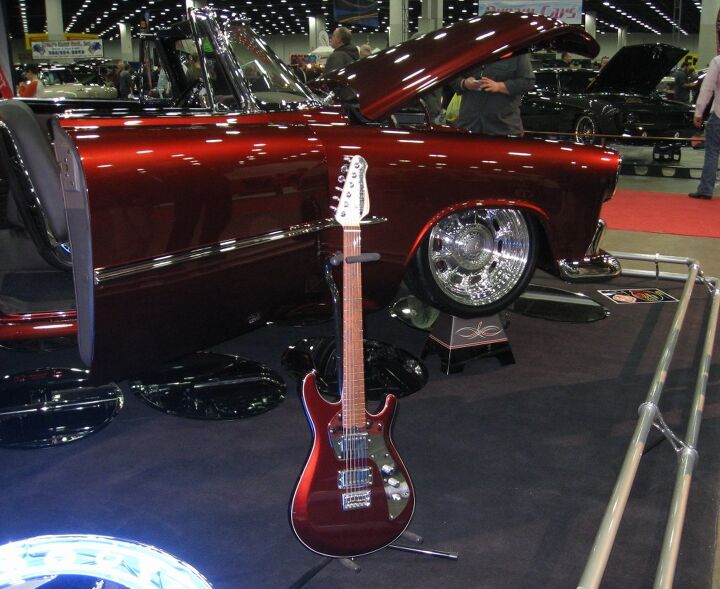





































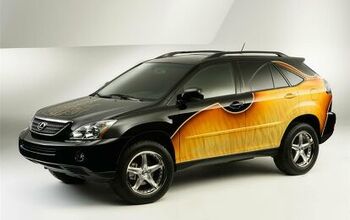

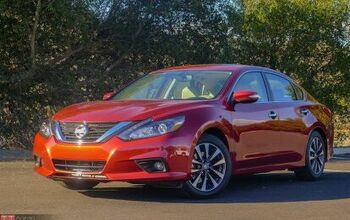
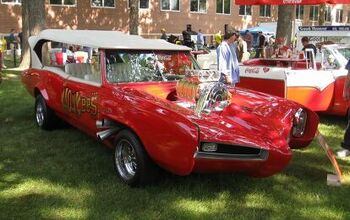










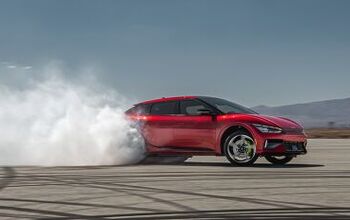
Comments
Join the conversation
The misaligned rivets on that brown guitar with the brushed silver pickguard is driving me crazy. The blue Ford prototype, however, is all kinds of neat.
"It wouldn’t make the most practical guitar in the world, the stingray wing shaped bout might dig into a player’s ribs..." Wouldn't matter if played standing up (with a strap), and many iconic solid body electrics were difficult or nearly impossible to play sitting down anyway (Gibson Firebird and Flying V come to mind). Oh, and I can't drive 55.